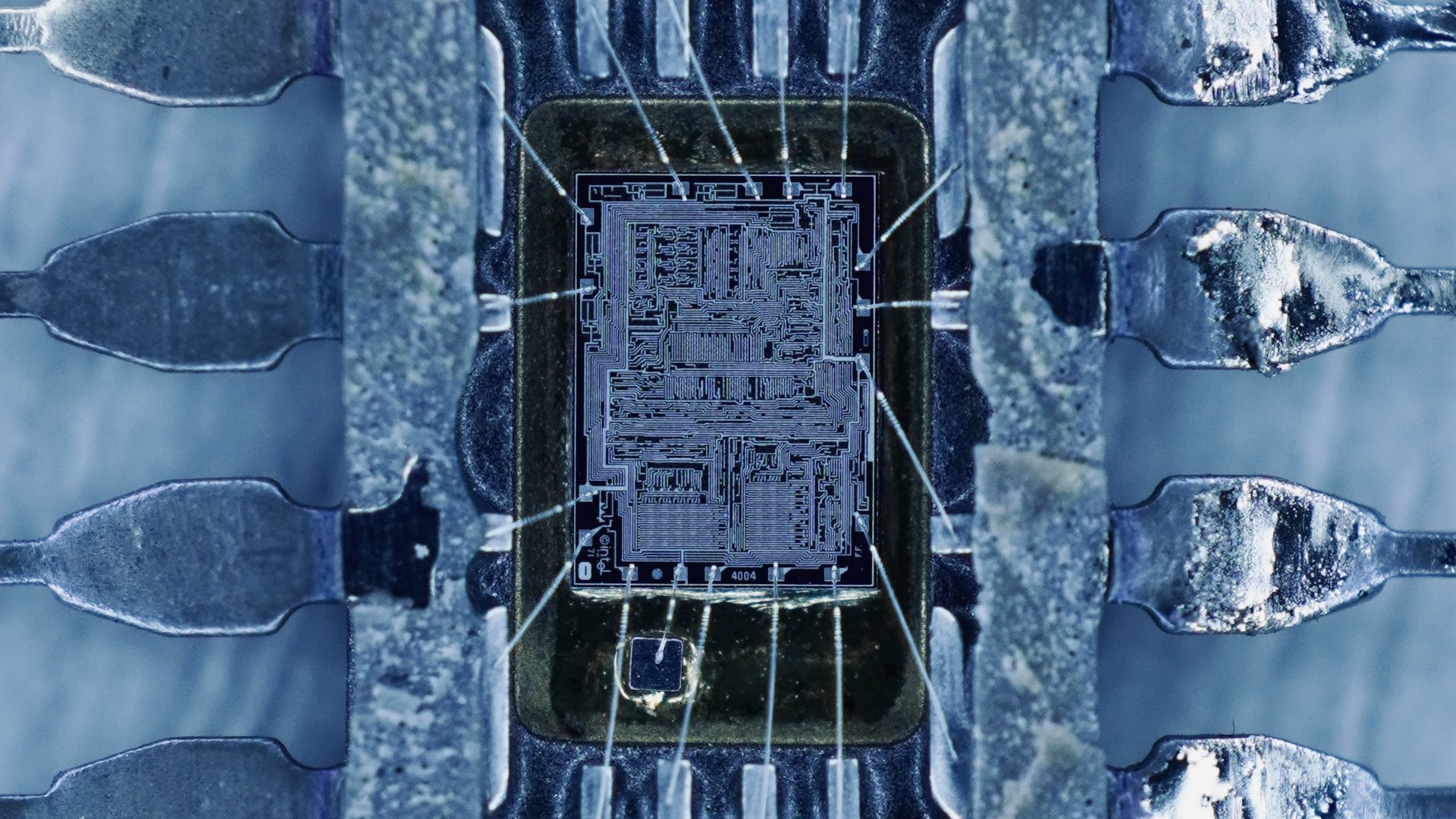Intel's revolutionary 54-year-old 4004 chip was the world's first programmable microchip — 2,300-transistor 10,000nm processor exposed
At 10,000nm, it doesn't take much magnification to see the chip's individual transistors.

CPU collector and enthusiast CPU Duke was given the opportunity to "pop the hood" off Intel's first-ever multi-purpose microprocessor, the 4004. In a post on X, the CPU collector removed the top portion of a 4004 processor, exposing its insides for them to explore with a microscope.
It doesn't take much zooming in to see the 10,000nm chip in all of its glory. In multiple X posts, CPU Duke showed off the 4004's internal wiring and the polysilicon structures beneath the chip's metal layer. CPU Duke even claimed he could individually count all 2,300 transistors on the chip in one such post.
The #Intel 4004 - the first single-chip microprocessor!Yes, I did it again, an old historic chip is decapped…but for a good cause! Thanks to the kind donation by the #Entertechnikwelt Computer Museum in Solothurn, Switzerland, I gave microscope this jewel.(2/n) https://t.co/0Qts8jKePu pic.twitter.com/ek4LgslyNrOctober 24, 2025
The Intel 4004 is a 4-bit processor featuring a clock speed of 740kHz, and a whopping 15V operating voltage (by contrast, modern processors operate in the 1.0V to 1.4V range). The maximum amount of memory the chip was able to address was a mere 4kB. The chip's clock speed doesn't paint how truly slow this chip is compared to modern chips, but for perspective, the 4004 can run 92,000 instructions per second. Rather than the billions of instructions per second, modern chips are capable of crunching.
The 4004 is considered the first modern microchip processor, being the first ever processor capable of being reprogrammed by software. Ironically, the 4004's design was first conceptualized for a calculator. In 1971, Intel was asked to create a twelve-chip set to build a desktop calculator for Busicom. But one of Intel's engineers, Ted Hoff, realized the concept would not work. Instead, he proposed a much simpler four-chip solution that could be programmed. This was the inception of the Intel 4004.
This was a radical change for Intel; before the 4004, chips could only be designed for specific functions. All the logic programming that those chips used was baked into their architecture. Programming revolutionized the computing industry, enabling microchip processors to perform different tasks without changing the hardware.
Ironically, Busicom was not happy with the Intel 4004 in its calculators. Due to a drop in market demand for desktop calculators at the time, Busicom wanted to renegotiate an inevitably cheaper price for the 4004. (It's also worth mentioning that Busicom owned the rights to the 4004 at this time.)
It’s the world’s first #CPU!Wow, seeing this historic chip first time with my own eyes is an unforgettable experience. Decapping went flawlessly, no bond wires damaged.And here it is X, the top metal layer of the 4004, Intel 1971, how cool is that!!! https://t.co/0Qts8jKePu pic.twitter.com/0bKfGCcEb0October 24, 2025
However, knowing the incredible potential of 4004, was capable of, Intel CEO Robert Noyce repurchased the rights of the 4004 at the urgent request of its design team. This would change the course of Intel forever, turning it into the giant multi-billion-dollar chip maker it is today.
Get Tom's Hardware's best news and in-depth reviews, straight to your inbox.
The 4004 would lay the foundation for the modern computing industry today. All modern processors use the 4004's same core concept, of being able to run various commands through programming. Taking this concept to the extreme, someone went so far as to boot Linux on the Intel 4004. It took over four days to boot, but it worked!
Follow Tom's Hardware on Google News, or add us as a preferred source, to get our latest news, analysis, & reviews in your feeds.

Follow Tom's Hardware on Google News, or add us as a preferred source, to get our latest news, analysis, & reviews in your feeds.

Aaron Klotz is a contributing writer for Tom’s Hardware, covering news related to computer hardware such as CPUs, and graphics cards.
-
aldaia Actually the first microprocessor was the much more powerful 20-bit MP944 that powered the Central Air Data Computer (CADC) of the US Navy fighter F-14 Tomcat, beating intel by one year. It remained unknown for several decades because it was classified.Reply -
MartinUsher I still have a copy of the 1972 Intel data book describing the 4004 and other parts of Intel's processor ecosystem (ROM, RAM, processors etc.). (If its not available online I'll scan it once we have somewhere to put it.)Reply
I think the Intel part could be considered the first processor just because it was sold to the public for whatever purpose they could think up. Its true that it took a few years for the public to catch on but that's because the rather daunting fixed costs of getting the parts and tooled up to use them meant that only a relatively few deep pocketed organizations could contemplate it. (My boss at the time was far sighted enough to realize the potential of these parts but his bosses nixed it -- too much investment etc. )("The usual".) The MP944 was really a specialized processor slice, it needed a lot more logic than just the specialized p-mos to logic level translators and clock generators to function. -
Lamarr the Strelok Reply
Ya the 4004 was the first commercial programmable chip it looks like. I surprisingly hadn't heard of the MP 944 so thanks for that. What a machine that must have been.It still sorta blows my mind the same hardware bits can be programmed to do totally different things. Certainly not free from controversy, but from just before the invention of the transistor to today, Intel has done some remarkable stuff.aldaia said:Actually the first microprocessor was the much more powerful 20-bit MP944 that powered the Central Air Data Computer (CADC) of the US Navy fighter F-14 Tomcat, beating intel by one year. It remained unknown for several decades because it was classified.
Great article. -
bobmon Reply
There are also some nice images at https://timeline.intel.com/, including this photomicrograph:Admin said:A CPU collector/enthusiast has taken the top off of an Intel 4004 processor and taken pictures of the chip's insides, showing the 10,000nm chip in all its glory.
Intel's revolutionary 54-year-old 4004 chip was the world's first programmable microchip — 2,300-transistor 10,000nm processor exposed : Read more
Each black square on this dieplot of the 4004 represents one transistor, the basic unit of power for a microprocessor. The 4004 processor contained 2,300 transistors in all. -
Yonov How gentle for Intel to describe the events of that time. Reality: Intel was a foundry that produced its own memories and at the same time produced the circuits of external developers. Exactly on the model of the current TSMC. They also offered a service to optimize the customer's design to fit well with their production process. Busicom appeared, who came with a design developed by them (logic circuit designer Masatoshi Shima), Ted Hoff offered them a better option for implementing a three-chip system, Fagin and Shima made the final version. I emphasize that all this was within the framework of a standard service for optimizing a customer design that Intel offered to its customers, without in any way acquiring the intellectual rights to the project. That is, the relationship was like that between a writer and a proofreader. But Intel realized the potential of the processor and pressured commercial Busicom to cede the rights to them. At the same time, they attracted Shima - the progenitor of the idea. I can't think of a more rude and brutal treatment from a foundry to its customer. Busicom is gone, but their shadow still hangs over Intel. Because you can only do something like that once. Now Intel is desperately looking for customers for its foundry, but everyone remembers the fate of Busicom...Reply -
pe2_dave Brings back memories. Returning home from training course (old 'dumb' terminals) which used two processors, one of which was 4004 .Reply
No seats on the train, I spent 4 hours reading the 4004 'manual' - my first intro to 'computers'